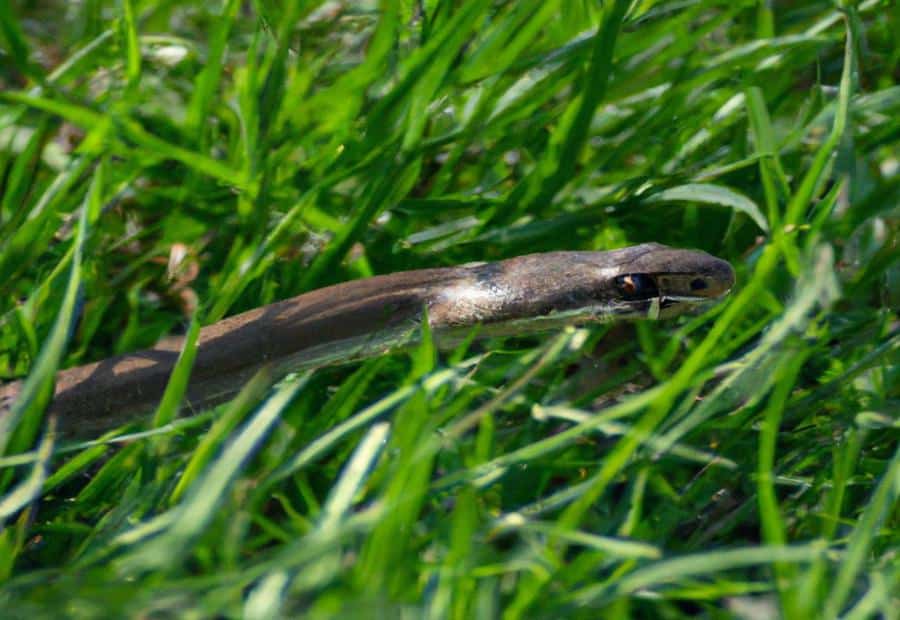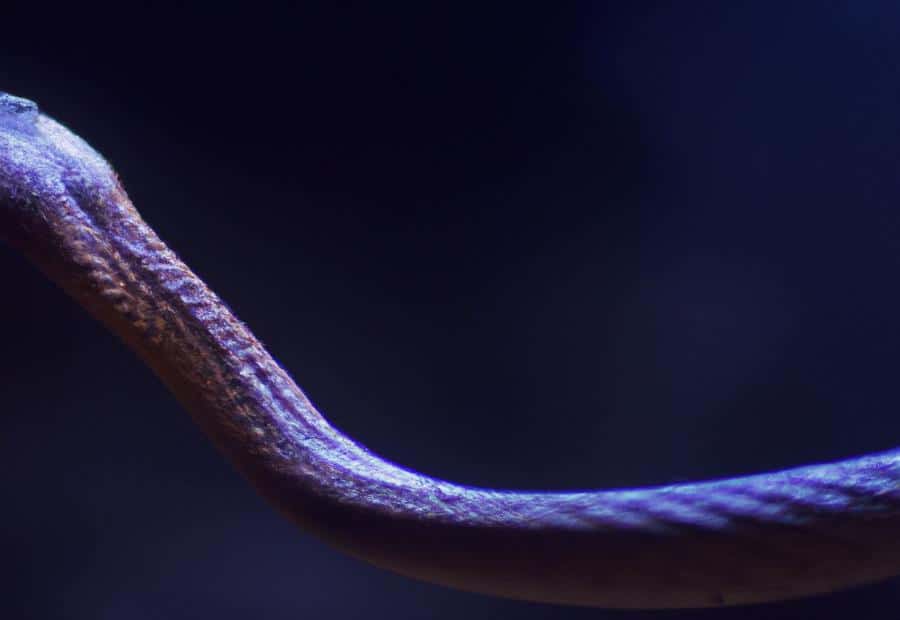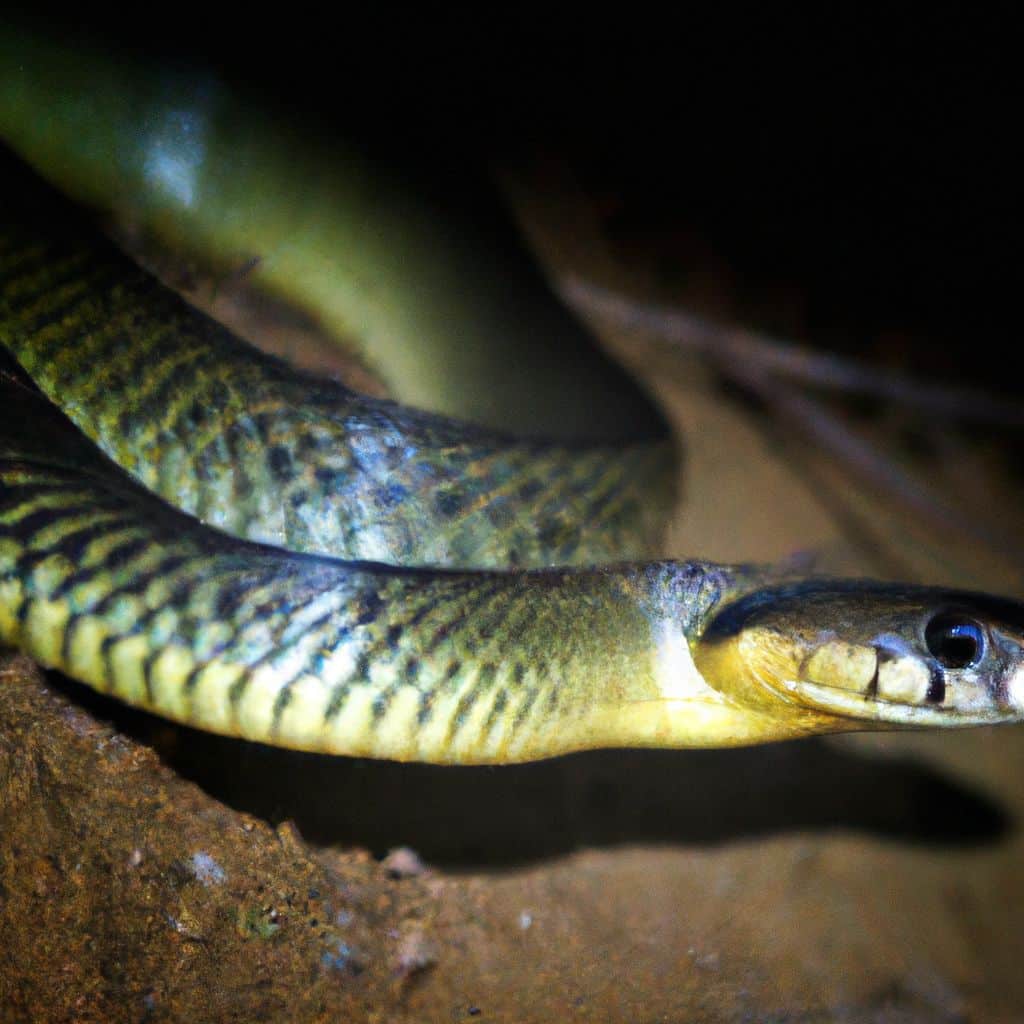Key takeaway:
- Lateral undulation is the primary mode of snake movement, allowing them to move efficiently across a variety of terrains.
- Snakes can achieve impressive speeds due to muscular and skeletal adaptations specifically designed for speed.
- The world’s fastest snakes include the Black Mamba and Southern Black Racers, capable of reaching remarkable speeds in their natural habitats.

Snakes are fascinating creatures when it comes to their movement. In this section, we’ll explore an overview of snake movement styles and uncover the importance of snake speed. Get ready to uncover the surprising facts and insights about how fast these slithery creatures can actually move.
Overview of snake movement styles
Snakes have various kinds of movement styles. A popular one is lateral undulation. This involves S-shaped curves, so the snake can push off the ground and go forward. But there are more! Sidewinding and rectilinear movement are two others.
Lateral undulation is the most used style. It’s a wave-like motion, which lets snakes go over different terrains and obstacles.
In sandy or slippery places, sidewinding is used. Snakes lift parts of their body and hop or jump sideways. That helps them on loose sand and slippery surfaces.
Rectilinear movement is slower. Snakes stretch out straight and contract their muscles to move ahead. This helps them when they need to maneuver narrow crevices or ambush prey.
All in all, snakes have various movement styles. Lateral undulation, sidewinding, and rectilinear movement are the three most common ones. They help snakes navigate their environment and fulfill their purposes.
Importance of snake speed
Snake speed is essential for survival and success. Quick motion helps them catch prey, dodge predators, and get around. Lateral undulation is the most-used movement style – a series of contractions along the body. This speed affects how far they move. Faster undulations mean more ground covered.
Different styles can be used, like sidewinding and concertina locomotion. Speed is still the key factor. Muscular and skeletal adaptations help them be speedy. An elongated body and no limbs reduce drag. Flexible spines aid quick turns.
Predator-prey dynamics make speed important too. Fast reflexes and movements help snakes hunt or escape. An example is the black mamba – the world’s fastest snake! It can reach 20 km/hr (12 mph) to pursue prey through fields and forests.
How Snakes Move

Snakes, fascinating creatures known for their unique locomotion, have various ways of moving. In this section, we’ll delve into the mechanics of snake movement, focusing on the primary mode known as lateral undulation, as well as exploring other intriguing movement styles they employ. Prepare to be amazed by the diversity and efficiency of these slithering creatures as we unravel the secrets of how snakes navigate their surroundings.
Lateral undulation as the primary mode of snake movement
Snakes primarily move by lateral undulation. This involves flexing their bodies from side to side in a wave-like motion. It enables them to travel through various terrains with ease.
Other modes of movement include concertina locomotion, where they anchor parts and extend forward. Certain species can even climb trees or fly!
Lateral undulation is by far the most common and efficient movement for snakes. They have adapted muscular and skeletal systems to enable precise and speedy movement.
The speed of snakes is important in predator-prey dynamics. It helps them capture prey or flee from predators. Thus, it plays a critical role in their hunting success.
Other movement styles in snakes
Snakes can move in various ways aside from the typical lateral undulation. These alternative methods help them to navigate various terrains and environments with ease.
One of these is sidewinding. Certain species of snakes lift parts of their body off the ground and push themselves forward with the remaining contact points. This slithering motion reduces friction on loose or sandy surfaces.
The next movement is concertina locomotion. This is when snakes anchor their rear ends and contract their muscles to propel themselves forward, while the front stays still. This is useful for squeezing through narrow spaces.
The third movement is rectilinear motion. Snakes like pythons use this to traverse smooth surfaces like tree branches or flat ground. They grip and pull with their ventral scales, enabling slow and precise movements.
These movements demonstrate snakes’ capability to adapt and survive in different habitats. They use different strategies, depending on the situation. Their muscular and skeletal adaptations help them travel through difficult terrains efficiently.
Factors Affecting Snake Speed

Snakes, known for their slithering movements, have a remarkable speed that can vary based on several factors. In this section, we’ll uncover the key elements that influence a snake’s speed. From examining their muscular and skeletal adaptations for speed to understanding the dynamics between predators and prey, we’ll explore the fascinating attributes that contribute to the incredible agility of these remarkable reptiles. (Reference Data: Snakes are capable of moving at speeds ranging from 0.05 to 14 miles per hour based on species and environmental conditions.)
Muscular and skeletal adaptations for speed
Snake speed is hugely dependent on their body adaptations. Muscles are arranged for powerful contractions, whilst rib bones move independently granting fluid motion. This boosts speed and agility in various terrains. The scales on a snake’s belly have “microstructures” to create friction with the ground, aiding in propulsion. Plus, their body shape transfers energy efficiently during movement.
Still, snake speed varies. Factors such as size, species, and environment can influence it. Some have adaptations to move swiftly in open landscapes or dense vegetation, whilst others rely on stealth.
Researchers studying these adaptations can gain insights for new tech or strategies to boost human speed and agility in different places. By understanding and incorporating these adaptations, researchers can explore ways to enhance human speed and agility.
Predator-prey dynamics and speed
Snakes are reptiles that have adapted to the predator-prey dynamics of nature. Their speed is influenced by their muscular and skeletal features. Powerful muscles along their body and a flexible vertebral column enable them to move quickly.
Speed can be a matter of life or death for a snake. It helps them escape predators, like birds or other snakes. It also helps them catch their prey.
Not all snakes rely on speed. Some have unique adaptations like camouflage or venomous bites to help them survive.
One fascinating example is the interaction between snakes and certain birds called “snake eagles.” These birds have adapted to hunt snakes while in flight. In response, some snakes have evolved to be faster and more agile.
Fastest Snakes in the World

Discover the lightning-fast world of snakes as we uncover the fastest snakes in the world. From the swift and deadly Black Mamba to the impressive speed of the Southern Black Racers in grassy landscapes, we’ll delve into the remarkable abilities of these serpents. Prepare to be amazed by their incredible agility and astonishing speed as we explore the realm of these slithering speed demons.
Black Mamba: The world’s fastest snake
The Black Mamba is recognized as the world’s fastest snake. It can reach speeds of up to 20 miles per hour (32 kilometers per hour), making it a fearsome reptile. This marvel of agility is feared and respected throughout the animal kingdom.
The Black Mamba‘s speed is driven by its unique lateral undulation. It slithers forward in serpentine motion, allowing it to swiftly cross grassy areas and other terrains.
This reptile’s velocity also derives from its predator-prey dynamics. As an apex predator, it must be able to strike and subdue prey quickly. Its powerful muscles and streamlined body shape give it the edge over other snakes.
Southern Black Racers: Impressive speed in grassy landscapes
Southern Black Racers are famed for their speed in grassy terrains. Unique movement style and muscular-skeletal adaptations give them an edge in speed. Predator-prey dynamics also contribute. They are agile and efficient when moving through grassy areas.
Their speed is due to special muscular-skeletal adaptations, which allow powerful undulations along their body, enabling lateral movement. This helps them navigate grasslands easily, aiding in prey capture and escape from predators.
Furthermore, the high-speed locomotion of Southern Black Racers is affected by predator-prey dynamics. Swiftness helps them avoid predation and hunt prey more effectively.
Comparing Snake Speed to Human Speed

When it comes to speed, snakes are often underestimated. In this section, we’ll compare the impressive speed of snakes to that of humans. Discover the surprising capabilities of these slithering creatures and gain a greater understanding of just how remarkable their speed truly is. Brace yourself for a thrilling exploration into the world of snake locomotion.
Snake speed vs. human speed
Snake Speed vs. Human Speed:
Exploring the speed at which snakes move compared to humans is fascinating. Snakes have adaptations in their muscles and skeleton that let them travel quickly in their natural habitats. This movement style is called lateral undulation. Humans have a different way of moving, called bipedal locomotion, and this limits our speed. Knowing about the speed of snakes and how it compares to human speed helps us understand these reptiles.
To compare snake speed and human speed, here is a table with some key factors:
| Factors | Snake Speed | Human Speed |
|---|---|---|
| Locomotion Style | Lateral undulation | Bipedal locomotion |
| Maximum Speed | Impressive | Limited |
| Muscular Adaptations | Specifically evolved muscles for fast movement | Muscles specialized for endurance rather than speed |
| Skeletal Adaptations | Flexible backbone allows rapid undulations | Rigid skeleton restricts range of motion |
| Habitat Preference | Varied environments | Predominantly terrestrial |
Comparing snake speed and human speed, we can see that snakes use lateral undulation to move quickly and efficiently. They have muscles to generate powerful force for each undulation. Also, their flexible backbone lets them move in different directions quickly. In contrast, humans rely on muscles for endurance rather than quick speed.
We should note that snake speed and human speed depend on their habitats. Snakes can thrive in many environments, from grassy areas to forests and water. This lets them move quickly for predator-prey dynamics. Human speed is usually optimized for land. While humans have other methods of transportation, like vehicles and bicycles, they don’t match up to snake speed.
Understanding the remarkable speed of snakes
Predator-prey dynamics help us understand the remarkable speed of snakes. Predatory snakes have adapted to swiftly chase down their prey. Prey animals may have strategies such as agility or camouflage to escape snake attacks. This emphasizes the importance of snake speed in survival and hunting.
Certain species of snakes are renowned for their speed. The black mamba can reach speeds of 12 miles per hour (19 kilometers per hour). Southern black racers are known for their speed in grassy landscapes, helping them ambush prey.
Comparing snake speed to human speed is important. Humans run faster than most snakes, but snakes have adapted to different environments and move with agility and control over uneven terrain, surpassing humans.
Conclusion

Snakes have developed diverse and effective methods of motion. Serpentine locomotion is their unique way of propelling themselves forward. They undulate their bodies from side to side, allowing them to zip through tight spaces quickly. The speed of a snake depends on its species, size, and habitat. For instance, the black mamba can go as fast as 12 mph (19 km/h). While other species like the anaconda may not be as speedy, they are incredibly powerful. Snakes are amazing creatures, with their impressive speed and abilities.
Some Facts About How Fast Can Snakes Move:
- ✅ Snakes can move quickly when startled or hunting, but generally not faster than a human can run. (Source: Team Research)
- ✅ Snakes achieve their speed through a combination of muscle control and friction. (Source: Team Research)
- ✅ Snakes have a long spine and pliable ribs, which allow for flexibility and efficient movement. (Source: Team Research)
- ✅ Snakes have thousands of muscles, compared to the hundreds in the human body. (Source: Team Research)
- ✅ Snakes use different modes of movement, including lateral undulation, sidewinding, concertina, rectilinear, and slide-pushing. (Source: Team Research)
FAQs about How Fast Can Snakes Move?
Snakes can move at different speeds depending on their species and size. The world’s fastest snakes, like the Black Mamba, Sidewinder, and Southern Black Racer, can reach speeds of up to 18 miles per hour in short bursts.
Snake speed can be influenced by various factors, such as size, muscles, scales, and environment. Larger snakes are generally slower but can cover more ground. The type and condition of their scales also affect their speed, as well as the muscles they use for movement. The environment they inhabit and their hunting habits also play a role in their need for speed.
No, snakes cannot outrun a human. While they can reach impressive speeds, such as 18 miles per hour for the fastest species, snakes slither instead of running with legs. The average human runner can achieve speeds of up to 20 miles per hour, which is faster than any snake.
No, not all snakes move at the same speed. Different snake species have varying speeds. The world’s fastest snakes, like the Sidewinder, Black Mamba, and Southern Black Racer, can reach speeds of up to 18 miles per hour. However, the average speed of most snakes is between 1 to 3 miles per hour, with some slower species never exceeding 1 mile per hour.
Snakes achieve their speed through a combination of muscle control and friction. They have thousands of muscles, compared to the hundreds in the human body. Snakes also have scales made of keratin that grip surfaces and propel them forward. Their long spine and pliable ribs allow for flexibility and efficient movement. The different modes of snake movement, such as lateral undulation, sidewinding, concertina, rectilinear, and slide-pushing, contribute to their ability to slither at different speeds.
No, most snakes are not aggressive towards humans. Snakes generally prefer to be left alone and will try to avoid encounters with humans. If faced with a snake in the wild, it is advised to stay calm and back away slowly. Snakes usually see humans as a threat and will usually respond with a flight reaction, only fighting if they feel cornered. It’s important to remember that snakes play an important role in the ecosystem and should be respected from a safe distance.








